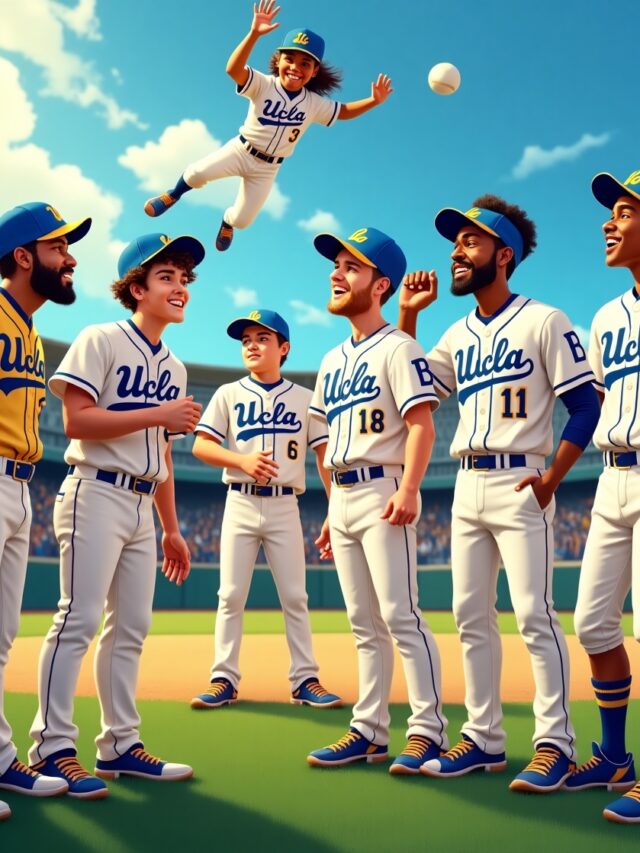NCAA Football Scores ESPN: A Journalist’s Eye-Witness Report
The roar of 90,000 people is a physical force. It’s not just sound; you feel it in your chest, a deep, primal vibration that travels from the stadium floor, up through your feet, and settles in your very bones. From my spot on the sidelines, notebook in hand and the smell of fresh-cut grass mixing with tailgate smoke, I’ve had a front-row seat to the controlled chaos that is NCAA football. I’m Mohit, and for years, I’ve been the guy chasing the stories behind the box scores, the human drama that unfolds between the hash marks.
You can sit at home and follow the NCAA football scores ESPN feed, watching the numbers tick up and down. You see the final results, the key stats, and maybe a few highlight reels. But what you don’t see is the tension in a quarterback’s jaw before a fourth-and-goal, the quiet confidence of a linebacker who knows exactly where the play is going, or the sheer, unadulterated joy that erupts from a sea of fans after a game-winning field goal sails through the uprights. This is my world. I live for these moments, the ones that don’t always make the final broadcast but define the very essence of college football.
This season has been a whirlwind of unforgettable moments, bitter rivalries, and Cinderella stories. I’ve traveled from the humid fields of the SEC to the crisp autumn air of the Big Ten, and I’m here to take you beyond the scoreboard. I want to share what I saw, what I heard, and what I felt from the best seat in the house—the one right in the heart of the action. This is my report from the trenches of college football.

The Symphony of Saturday: More Than Just a Game
Before we dive into the marquee matchups and shocking upsets, it’s crucial to understand what makes Saturdays in the fall so sacred. It begins hours before kickoff. Arriving at the stadium is an experience in itself. The campus transforms into a sprawling festival. Tents pop up in a kaleidoscope of team colors, grills sizzle with burgers and hot dogs, and the air is thick with anticipation and the sounds of fight songs. It’s a community gathering on a massive scale.
As a journalist, I bypass some of the tailgating festivities to get my credentials and head down to the field. The stadium, still mostly empty, has a cathedral-like quality. The silence is profound, a stark contrast to the explosion of noise that’s just a few hours away. You see the grounds crew making their final meticulous preparations, painting the lines with a steady hand. You watch the players start to trickle out for their initial warmups—some are loose and joking, others are intensely focused, headphones on, already in their own world.
This pre-game ritual is where the stories begin. I once watched a freshman running back, about to play his first-ever college game, walk to the end zone and simply touch the grass, a look of pure awe on his face. He was no longer just a kid; he was part of something bigger, a tradition stretching back generations. These are the human elements that a simple score update can never convey.
SEC Showdown: The Swamp’s Roar and a QB’s Redemption
My first major stop this season was in Gainesville for a classic SEC East clash. The humidity was oppressive, even for a night game. The air felt heavy, charged with the energy of over 88,000 fans packed into Ben Hill Griffin Stadium, famously known as “The Swamp.” The noise was relentless. It’s an environment designed to intimidate, to swallow opponents whole.
The game itself was a defensive slugfest for three quarters. Neither offense could find a rhythm. Punters were getting more action than the star quarterbacks. Fans were growing restless, the initial roar simmering down to a nervous murmur. You could feel the frustration mounting. On the home team’s sideline, I watched the starting quarterback get an earful from his offensive coordinator. His body language was defeated; his head was down. He had thrown two costly interceptions, and the game was slipping away.
Then came the fourth quarter. After another stalled drive, the coach made a gutsy call, a call that would either make him a hero or a fool. He stuck with his struggling quarterback. On the ensuing possession, something clicked. Maybe it was the coach’s faith, or maybe it was the quarterback’s own resolve. He led the team on a 90-yard drive, making sharp, decisive throws he hadn’t made all night. The crowd, sensing the shift, came alive. The murmur grew back into a deafening roar.
With under two minutes left, on a crucial third down, he threaded a pass between two defenders for a touchdown that sent the stadium into a frenzy. The concrete beneath my feet shook. I saw grown men with tears in their eyes, hugging strangers. The quarterback, once the picture of dejection, was now mobbed by his teammates, a look of pure relief and triumph on his face. The final score would show a narrow victory, but it would never tell the story of that one player’s journey from despair to redemption within the span of a single quarter. It’s a narrative far more compelling than any statistic..

The Big Ten Battle: A Game of Inches in the Snow
A few weeks later, I found myself in a completely different environment. I was in Ann Arbor for a late-season Big Ten rivalry game. A surprise snowstorm had blanketed the region, turning “The Big House” into a winter wonderland. The temperature hovered just below freezing, and a steady flurry of snow fell throughout the game, creating a scene straight out of a football movie.
Playing in these conditions changes everything. The ball is hard and slick. Footing is treacherous. Every play becomes an adventure. This wasn’t a day for flashy aerial attacks; it was a day for old-school, smash-mouth football. It was about which team could control the line of scrimmage, protect the football, and endure the elements.
From the sideline, the physicality was astounding. The thud of pads colliding echoed in the cold air, sharper and clearer without the usual wall of sound from a sun-drenched stadium. Players’ breath plumed in front of their faces. During timeouts, they would huddle around sideline heaters, their helmets and shoulders caked in snow. This was a battle of will as much as skill.
The game came down to a single, pivotal play in the final minutes. The visiting team was trailing by four and driving. They faced a fourth-and-one from the five-yard line. The stadium was surprisingly quiet, a collective breath held by over 100,000 people. The quarterback took the snap and surged forward in a QB sneak. From my angle, it was impossible to tell if he had crossed the line. A massive pile of humanity formed at the goal line.
For what felt like an eternity, the referees dug through the pile. Players from both sides were signaling victory. .
The tension was almost unbearable. Finally, the referee emerged, arms spread wide, signaling that the runner was short.
The home crowd erupted, a wave of relief and celebration washing over the snowy stands. The game was won not by a spectacular touchdown, but by a few inches of frozen turf. The box score would simply read “turnover on downs.” But for everyone in that stadium, those few inches were the difference between a season-defining win and a heartbreaking loss. This is the drama that keeps us glued to the sport. When you check the NCAA football scores ESPN app, you see the result, but you miss the frozen-breath tension of a hundred thousand people waiting for a single measurement.
Pac-12 After Dark: The Upset No One Saw Coming
There’s a certain magic to the late-night Pac-12 games, often dubbed “Pac-12 After Dark.” With most of the country winding down, these West Coast contests often produce some of the wildest and most unpredictable outcomes. I was in Eugene, Oregon, for what was supposed to be a routine home victory for a top-10 ranked team. The opponent was a scrappy, unranked team with a losing record. On paper, it was a mismatch.
The home team came out flat. You could see it from the opening kickoff. Passes were just a little off-target, tackles were being missed, and a general lack of energy pervaded their sideline. The underdog, on the other hand, played with a reckless abandon. They had nothing to lose, and it showed. They took risks, going for it on fourth down and dialing up trick plays.
As the game wore on, a strange feeling settled over the stadium. The confident cheers of the home fans turned into groans of frustration, then into nervous silence. The underdog wasn’t just hanging around; they were controlling the game. Their quarterback, a little-known junior, was playing the game of his life, escaping pressure and making incredible throws on the run.
I focused my attention on the two head coaches. The home team’s coach grew more and more agitated, pacing the sideline, furiously scribbling on his play sheet. In contrast, the visiting coach was a picture of calm, coolly encouraging his players and sticking to his aggressive game plan. He had instilled a belief in his team that was palpable.
The final moments were a blur. The underdog scored a late touchdown to take the lead. The home team had one last chance, a Hail Mary pass as time expired. I stood near the end zone, watching the ball hang in the night sky. For a split second, it looked like the home team’s receiver might come down with it, a miracle finish to salvage the game. But the ball was tipped, falling harmlessly to the turf.
Silence. A stunned, deafening silence from the home crowd. On the other side of the field, pure chaos. The underdog’s entire team stormed the field, a celebration of raw, unfiltered emotion. They had pulled off one of the biggest upsets of the year. I spoke with their coach after the game. He wasn’t surprised. “I told our guys all week,” he said, his voice hoarse, “believe you belong on this field, and you can win. Tonight, they believed.” That night, the scoreboard told a shocking story, but the real story was about the power of belief against overwhelming odds.

The Human Element: Beyond the X’s and O’s
As a journalist, I’m trained to be objective, to report the facts. But after years of covering this sport, it’s impossible not to be moved by the human stories that play out every Saturday. It’s not just about the players; it’s about everyone involved.
I’ve seen trainers work tirelessly to get an injured star back on the field, their dedication often going unnoticed. I’ve seen equipment managers who are the first to arrive and the last to leave, ensuring every helmet is polished and every jersey is perfect. I’ve seen student managers, often volunteers, who chase down stray footballs and fill water bottles with the same passion as the starting quarterback. These are the unsung heroes who form the backbone of every program.
And then there are the fans. I once met a family who had been season ticket holders for over 50 years. They sat in the same seats their parents and grandparents had sat in. For them, game day was a family reunion, a tradition that connected generations. The outcome of the game mattered, of course, but what mattered more was the shared experience.
This connection between the team, the university, and the community is what sets college football apart. These players aren’t just hired professionals; they are students. They walk the same campus, attend the same classes, and are part of the same community as the fans who cheer for them. That’s why the victories feel so personal and the losses sting so deeply.
When I file my reports, I always try to include these details. I want my readers to understand the context behind the score. I want them to know about the freshman’s nerves, the senior’s leadership, and the coach’s gamble. I want them to feel the chill of the snow and the heat of the Florida sun. Because football is more than just a game of numbers on a screen.
As this incredible season continues to unfold, I’ll be there on the sidelines, notebook in hand, ready to capture the next chapter. I’ll continue to follow the thrilling finishes and track every update to the NCAA football scores ESPN provides, but I’ll always be looking for the story behind the score. Because in the heart of the noise, the passion, and the pageantry, that’s where the real magic of college football lives. It’s a privilege to witness it firsthand, and an even greater one to share it with you.










